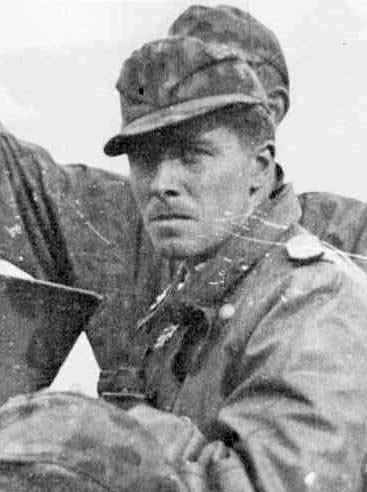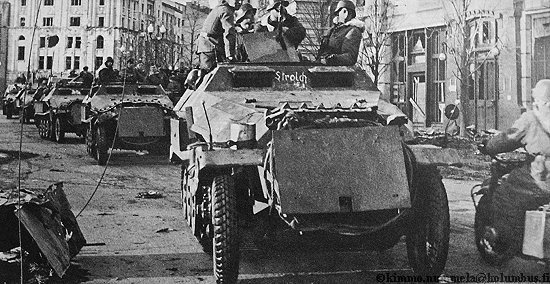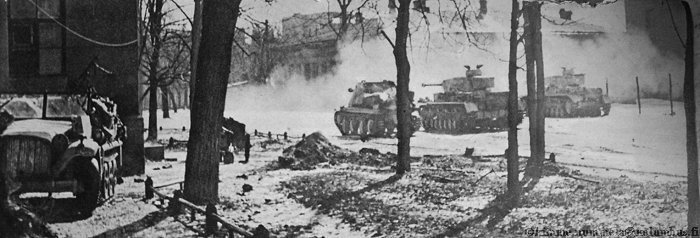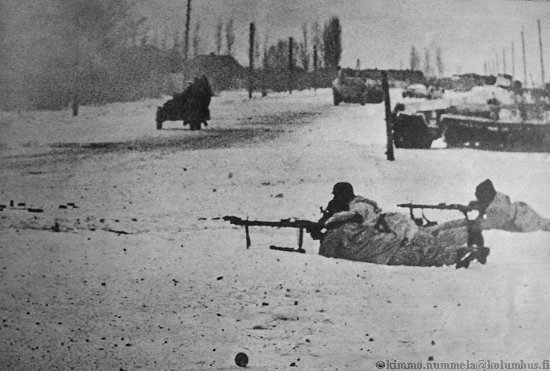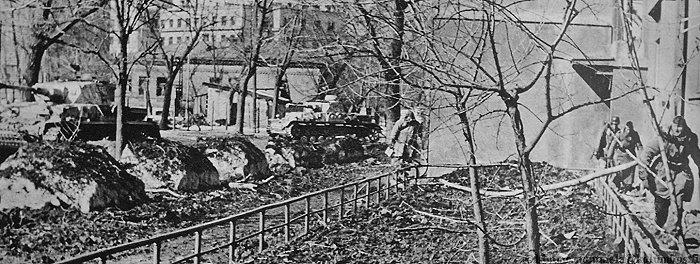Peiper's "Blowtorch" Battalion A Combat Mission Scenario Series A CMBB combat history of the III. (gep)/ SS-Pz.Gren.Rgt. 2 commanded by Jochen Peiper, following its actions from the 3rd Battle of Kharkov in the winter of 1943, to the conflagration of Kursk in the summer of 1943. Researched and created for CMBB by Charlie Meconis and George McEwan. Formation of the III. (gep)/SS-Panzer Grenadier Regiment. 2
Peiper commanded the SPW battalion (III. (gep)/SS-Panzer Grenadier Regiment) until the death in action of the commander of SS Panzer Regiment 1, SS-Obersturmbannfuhrer Schonberger, on the 20 th November 1943. The Divisional commander SS-Oberfuhrer Wish gave Peiper the command of the Panzer Regiment. At this time Peiper had no experience of commanding a tank unit; his promotion was based solely on his previous successes, and his reputation for aggressiveness. Peiper handed over command of the Blowtorch Battalion to the commander of the 11. (gep) Kompanie, SS-Haupsturmfuhrer Paul Guhl. About the Blowtorch Battalion scenarios
Jochen Peiper is quoted in the biography by Agte as saying the nickname came about due to their innovation of successfully attacking tough Soviet positions in villages with high-speed night assaults, mounted in their new halftracks. The thatch in the houses roofs caught fire due to tracer rounds etc - hence the nickname. This nickname was then given different connotations after the war with the allegation, denied by Peiper, that the unit deliberately set fire to houses with blowtorches. After the war this allegation formed part of the case that was made against Peiper for his being tried for war crimes. Given the total and brutal nature of the war in the East, it is likely that Peiper and his troops both committed and were the victims of war crimes in terms of international law. No one came out of that apocalypse called World War II with their hands really clean. We do not condone those actions. This series of scenarios recreating several of the actions involving Peiper's unit were born out of a desire to recreate some rather audacious, courageous and ultimately bloody actions that were fought by both Soviet and German units during the winter of 42/43 around Kharkov, and latter in the summer of 1943 during the epic Battle of Kursk.
Both authors have been very meticulous to research the Soviet side and give the Soviets their own identity rather than a faceless 'Red Horde' - as the bravery shown by the Soviet units during this fighting was exceptional. Although it should be borne in mind that to date, Soviet sources are still not as detailed and complete as German ones are. It is to be hoped that through time these sources will become more available in English, so that the efforts and contributions of the Soviet soldiers to the victory over Nazi Germany will become as well known.
You can read more about The Third Battle of Kharkov here. Or The Battle of Kursk here. The Blowtorch Scenarios There are seven scenarios currently in the series. The first five cover the desperate mobile counterattacks and blocking actions against the Soviet 6 th Guards Cavalry Corps, the brutal mobile street fighting in Kharkov and Peiper's headlong drive to seize the city of Belgorod. Whilst the last two are set during the Battle of Kursk, or Operation Citadelle in which Peiper's unit found itself in the middle of attacking Soviet tanks and infantry. Click on the highlighted title to see the full scenario details and download the file. Peiper's Chariots of Fire 7 th February 1943 Peiper's Blowtorch Battalion fights to hold the village of Andrejewka against attacks from the Soviet 6 th Guards Cavalry Corps. Operation Peiper 13 th February 1943 Peiper's III Blowtorch' (armoured) Battalion from SS Panzergrenadier Regt 2 conducts a deep penetration mission to rescue the 320 th Heart Infantry Division during the Battle Of Kharkov, February 1943. Bridgehead at Fedorowka 6 th March 1943 Peiper's III Blowtorch' (armoured) Battalion from SS Panzergrenadier Regt 2 attempts to seize a bridgehead over the Msha River during the Battle Of Kharkov, Winter 1942 - 1943. Peiper's Bridge in Kharkov 13 th March 1943 The Blowtorch Battalion must fight through Kharkov to link up with Panzermeyer's Kampfgruppe surrounded at the cemetery near the crucial Volchansk Chuguyev crossroads. Peiper's Race for Belgorod 18th March 1943 Not available till 2006 The Blowtorch Battalion races to take Belgorod before powerful Soviet reinforcements arrive from Stalingrad Peiper's Nahkampftag* 8 th July 1943 Peiper's battalion whilst attacking towards Teterovino during the Battle Of Kursk, was counter attacked by strong Soviet armour and infantry units. Surrounded, Peiper had a call for help sent out and elements from the 7. /SS-Panzer regiment were ordered to fight their way through, and make contact with the beleaguered panzer grenadiers. *Note: Nahkampftag means close combat day. Born Again Near Prokhorovka 12 th July 1943 Soviet counter attack against the 1 st SS LSSAH Panzergruppe (of which the Blowtorch Battalion was part) at Prokhorovka. During this action both Obersturmfuhrer Rudolf Von Ribbentrop, commander of the 6 th Company II Abteilung 1 st SS Panzer Regiment, and Untersturmfuhrer Werner Wolff of the Blowtorch battalion (Peiper's Adjutant who took command of the 13 th Company when it's CO, Wendt, was wounded on the 12 th July during the Soviet attack) won the Knights Cross. Blowtorch SPW Mods for CMBB Using original art from Dey and Pat I have modded the SPW (250/1; 251/1; 251/10; 251/2) used by the Blowtorch Battalion during the winter of 1943. The modded vehicles have extra bits and pieces hanging off them such as kit and tarpaulins, plus they have Leibstandarte and tactical insignia, SS plates and the Blowtorch symbol. Many thanks to both Pat and Dey for their permission to make public these mods. I have also used several bits and pieces from other artists (flag, tarpaulin, track). As of yet I have been unable to track them down. If you recognise any of your art please accept my apologies for using it without your permission. Download Blowtorch Battalion Winter 1942 - 43 SPW Information Sources All of the following were found to be of great help in preparing the scenarios. On the net http://www.feldgrau.com/1ss.html German unit histories and much more http://www.battlefield.ru Excellent site covering the Soviet view of war in the East. http://mapy.mk.cvut.cz Superb source of 1:100,000 maps of the Ukraine. Books and Publications The following books were all invaluable in providing information crucial to creating these scenarios. Jochen Peiper by Patrick Agte After the Battle: The Four Battles for Kharkov No112 Red Army Tank Commanders: The Armored Guards by Richard N. Armstrong Last Victory in Russia: the SS Panzerkorps and Manstein's Kharkov Counteroffensive by George M. Nipe Jr The Leibstandarte Vol III by Rudolf Lehmann From the Don to the Dnepr: Soviet Offensive Operations December '42-August '43 by David Glantz Panzer Aces I by Franz Kurowski Grenadiers by Kurt Meyer Armour Battles of the Waffen SS, 1943 45 by Will Fey Chronicle of the 7. Panzer Kompanie 1st SS Panzer Division Leibstandarte by Ralf Tiemann The SS Panzer Artillery Regiment 1 Leibstandarte Adolf Hitler by Thomas Fisher Soviet Armour Tactics in World War II by Charles C. Sharp Battle Group! by James Lucas The Battle of Kharkov by Jean Restayn Platz der Leibstandarte by George Nipe Jr & Remy Spezzano Slaughterhouse: The Handbook of the Eastern Front, David Glantz, et al. The Red Army Order of Battle in the Great Patriotic War by Robert Poirer and Albert Conner Colossus Reborn and Colossus Companion by David Glantz The Battle of Kursk by Glantz and House Operation Zitadelle July 1943: The Decisive Battle of World War II by Franz Kurowski The Battle of Kursk by Robin Cross Steel Storm: Waffen SS Panzer Battles of the Eastern Front 1943 - 1945 by Tim Ripley Panzertaktic by Wolfgang Schneider You can order these books from Amazon.co.uk at the link below. Special Thanks The images of the street fighting in Kharkov used to illustrate this page are used by very kind permission of Kimmo Nummela, who's website www.silentwall.com has a whole host of original WWII Eastern Front photos. It's well worth a visit. Thank you Kimmo.
|
